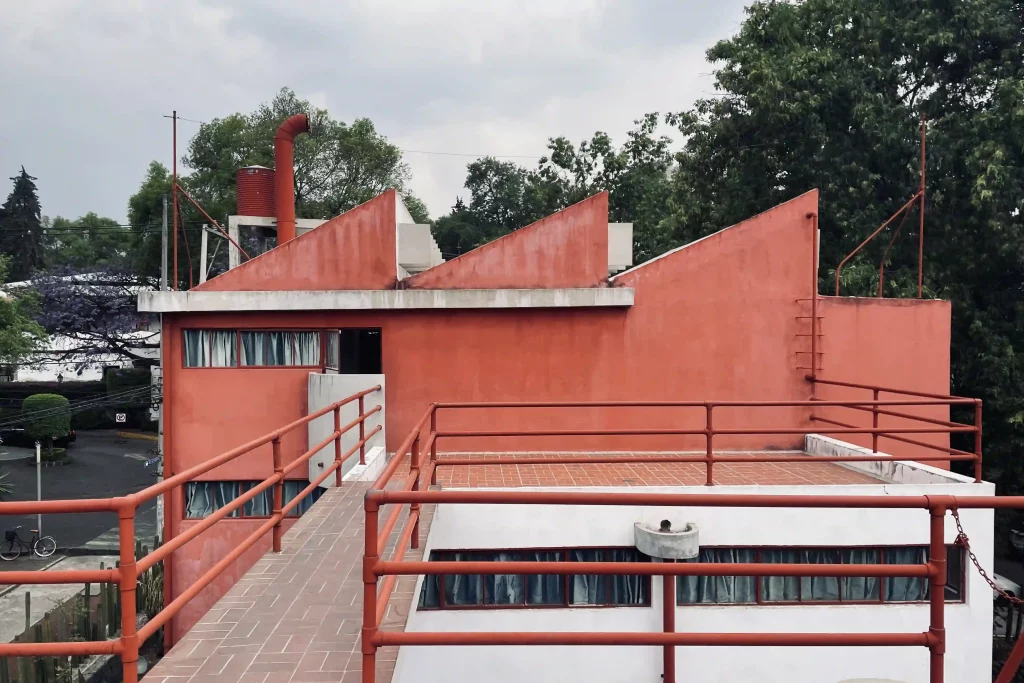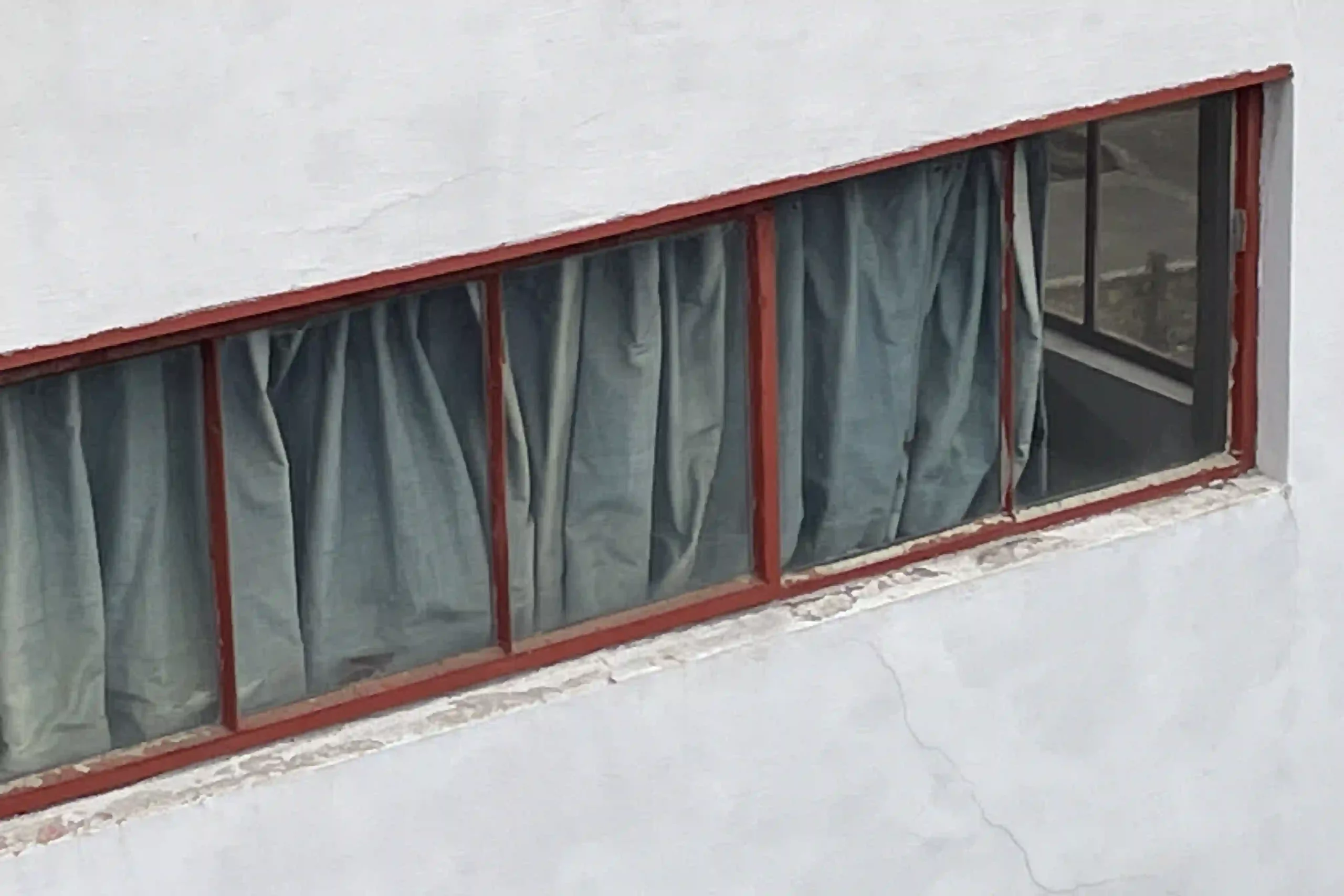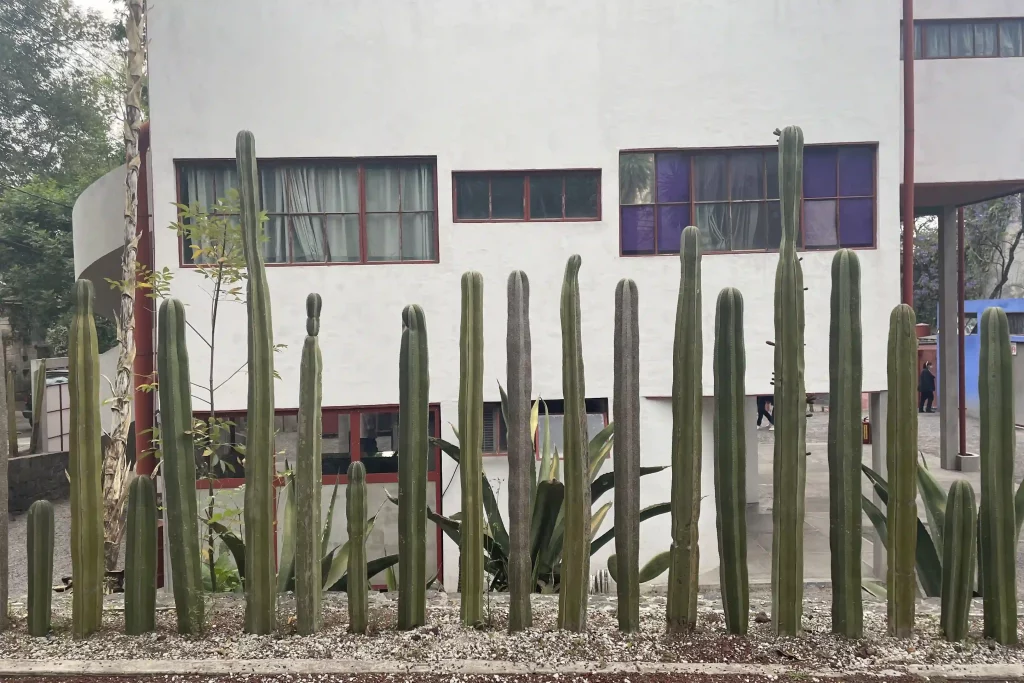Commissioned by the couple from the architect Juan O’Gorman in 1931, Diego RIvera and Frida Kahlo lived in the estate until 1934
Frida Kahlo and Diego Rivera
Known as the most admired Mexican artists of the 20th century, the couple met in 1928 and married a year later. After a period of time working in the United States, they came back to Mexico and commissioned a place where they could live and make art. Friend of the couple and architect Juan O’Gorman took the lead of the project and created the estate.
A singular space in San Angel, Mexico City
Juan O’Gorman studied functionalism and was inspired by the work of the Swiss designer Charles-Édouard Jeanneret, also known as Le Corbusier. He was interested in the idea of creating one of the first modernist buildings in Mexico City. His project provoked hostile reactions from other residents of the neighborhood, known for its eighteenth century colonial style. Despite the criticism, O’Gorman built the artist’s residence-workshop that became a symbol of functionalism in Mexico.
Redefining Functionalism: Museo Casa Estudio Diego Rivera and Frida Kahlo
The two buildings embody the principles of the functionalist movement. Every detail of the building has a purpose. The purpose of this style is to remove all elements that do not have a practical role. there is no decoration or superfluous materials. Functionalism revolves around concrete, glass and steel. However, O’Gorman decided to appropriate this European style by adding materials often used in Mexican architecture. We can observe the addition of clay and other vegetal elements in the construction.
Another plant-inspired idea is the replacement of concrete fence or other solid materials with cactus surrounding the property. These plants give an impression of opening while delineating the space and adding a touch of color.
As for color, it takes a primordial place in this architectural ensemble. Usually white or gray, functionalist buildings can give an austere air. Here, Frida Kahlo and Diega Rivera added a touch of their personality. They chose bright colors, closer to the Mexican style, known for being colorful and bold. Another element that catches our attention is the stairs. Their helical shape can be considered as the only purely aesthetic element in the exterior of the property. They are located on each side of the houses and provide direct access to the rooms.
The drainage system of the water on the roof also gives these buildings a more sought-after appearance. They were left in view of the visitors, bringing a transparent side to the construction. All these elements were painted in a contrasting color to the rest of the building to give a more homogeneous appearance. The roof of Diego Rivera’s house is inspired by functional industrial design. Like factories, the roof takes a shed shape. This technique is used to allow light to enter a large building more easily and homogeneously. Here, the purpose of this roof also gives an aesthetic aspect in addition to being functional.
Diego Rivera’s house
The Mexican painter occupied the red-rusty and off-white house. He chose more natural tones compared to his wife’s house which is painted in cobalt blue. On the floor level, there is a bridge that connects the painter’s house to that of Frida Kahlo. In the initial project, the bridge was not designed with railings. This is a surprising choice given Kahlo’s fragile mobility. Both houses have been designed to give the impression of being constantly open to the outside. The windows in the workshops are floor to ceiling, leaving a thin glass panel separating the interior from the exterior. This choice allows the artists to be always connected to the sunlight and their yard.
The access to Diego Rivera’s house is through the spiral staircase that can be found outside. This leads directly to a room where the artist exhibited his works for sale. Continuing up the stairs is the bedroom of Diega Rivera. In keeping with functionalist ideology, the rooms intended for rest were always smaller than the other rooms. Bedrooms are considered to be places where we don’t spend a lot of time, so it is not necessary to dedicate much space to them according to the functionalist rules.
Diego Rivera: connecting to Frida Khalo’s house
Unlike the rest of his house, the bedroom has small windows at the top of the wall. This choice allowed Rivera to have less light so as not to be disturbed by the heat and sun. There is a small bed and some strictly necessary furniture. Attention is paid to those elements that have remained untouched since Rivera’s death. We see a suitcase, a pair of shoes belonging to him, and some paper-mâché dolls. These dolls, typical of Mexican culture, were collected by the artist.
The largest room in Diego Rivera’s house is the studio. Like his bedroom, nothing has been moved since his death. Here, the high ceilings and large windows allow the sun to take over. The tools of the painter are intact and allow us to observe his way of working as well as his color palette. The studio is decorated with large papier-mâché dolls that represent traditional characters from Mexican culture. These dolls are called «Judas» in Mexico. They represent mostly demons, skeletons and other characters considered negative by the Mexicans.
A mezzanine overlooks the workshop. It is arranged as a small living room and office for the artist. From this mezzanine there is access to the rooftop. The floor of the rooftop is covered with bricks of the same red-rusty color found on the façade of the house. From this rooftop you can see a view of the San Angel neighborhood where the two artists’ houses are located. This view allows us to confirm that the property of Frida Kahlo and Diego Rivera is atypical. The neighboring houses are in the colonial and neo-colonial style, a detail that accentuates the difference of the museum. It is here that we find the footbridge that leads to Frida Kahlo’s house.
Frida Kahlo’s house
The first detail that draws attention to Frida Kahlo’s house is its color. Indeed, the painter chose this cobalt blue as a reminder of the house where she was born, in 1907, La Casa Azul. Another detail not found in Diego Rivera’s house is the small, simple construction built adjacent to one of the two property lines. This construction is in fact a photo studio that was built for Frida Kahlo’s father, Guillermo Kahlo, who was a photographer.
Inside the painter’s house are a bathroom, a kitchen, a dining room and a bedroom. Frida Kahlo’s workshop is on the first floor. Compared to Diego Rivera’s house, the space here is narrower. Unlike her husband’s house, few decorative or furnishing elements remained in Kahlo’s house. It was in this bathroom that she found the inspiration for her 1937 work, Lo que el agua me dio.
Despite the divorce and reconciliation between the couple, Frida Kahlo decides not to continue living in the same place as her husband. She retired to her childhood home, La Casa Azul, where she also died in 1954.
The Guest House
First designed to establish the architect’s vision in the space, the guest house sits slightly below the other two houses. The house was acquired by the museum in 2012 during a restoration phase. It was originally used by the couple to accommodate their friends and families. Construction of this building began in 1929, two years before the two houses were begun.
On top of the pillars that lift it is a large room surrounded by bay windows. These windows can be opened to let the sunlight in and to let the air out.
The guest house consists of a bedroom, a bathroom, a kitchen and a dining room.
In this dining room there is a detail that was discovered in 2012 by the museum’s restoration team. A mural painted by the architect of the house, Juan O’Gorman. This mural is called Entre filosofía y ciencia and was painted in the thirties. Following Rivera’s death, the fresco was purchased by the Banco Nacional de México and only a preparatory sketch remains on the wall.
The evolution of Museo Casa Estudio Diego Rivera and Frida Kahlo in time
Following the death of Diego Rivera in 1957, the property was inherited by his daughters. They started a series of works that changed the original construction. In 1986 the Rivera house was bought by the Instituto Nacional de Bellas Artes and became a museum.
Frida Kahlo’s house was not attached to the museum until 1997. In that same year, work was done to restore the property to its original condition as it was in 1932. 2012 is the year the museum acquired the guest house also called the Juan O’Gorman House.
Museo Casa Estudio Diego Rivera and Frida Kahlo
Built in 1932 by Mexican architect Juan O’Gorman, Museo Casa Estudio Diego Rivera and Frida Kahlo is a symbol of functionalist architecture of the early twentieth century. These two houses bear witness to the love between Diego Rivera and Frida Kahlo. The couple lived there for two years, until 1934.
Cristian Tonea






















